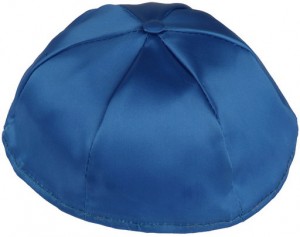
by Merissa Nathan Gerson
The Satin Kippah
 Recently at a gas station I saw a kippah on the security camera. It struck me as odd and exciting to see not only a kippah but a woman with a kippah at a Berkeley, CA gas station. It took a moment to register the black dress, the pink belt, and a wave of fear arrived when I realized the woman in the security camera was me.
Recently at a gas station I saw a kippah on the security camera. It struck me as odd and exciting to see not only a kippah but a woman with a kippah at a Berkeley, CA gas station. It took a moment to register the black dress, the pink belt, and a wave of fear arrived when I realized the woman in the security camera was me.
I took a job at a Masorti Conservative congregation’s Hebrew School earlier this year. Part of the job description included a clause that I was to wear a kippah while teaching Torah, while in the synagogue sanctuary, or while eating. The expectation was welcome after a year in a Modern Orthodox community where my sporadic use of a kippah never failed to garner laughter and shock, and sometimes a feminist nod.
On the contrary, at this Masorti synagogue I am obliged to wear one and fit in just fine. But when I exit the building, almost immediately, I make a point to remove the kippah. The only outside of synagogue kippah wearing occurs when I help the students cross the street to the park. And for even just that there is always a self-conscious awareness. I imagine the thoughts of the on looking cars and park dwellers like I did helping my wheelchair-bound friend cross the street in high school. Their imagined thoughts, like “look at the Jewess and her flock,” or “wow, poor guy, look at this woman helping him,” both bothered and affirmed me.
So to avoid imaginary judgments, to sidestep being a spokesperson for a people, or a martyr for that matter, I remove the kippah. It was an accident on this particular day that I pumped gas with my yarmulke on. A friend met me at the gas station en route to dinner and I blushed and quickly removed the kippah. I was more than happy to wear it at synagogue, but wearing it in public, to be seen and to be recognized as a pious woman is a whole other story.
It is about piety, about Jewish fear, about fears of being “The Jew,” and also being “That Jew.” The friend I met was raised Orthodox and was now an LA IKAR convert, his politics of gender perhaps as liberal as my own. And still, I couldn’t handle it. I told him how shocked I was to see the kippah in the camera, and how even more shocked, almost terrified I was to realize I had gone in public like this. I took note of my shame and of my fear.
Tonight at Simchat Torah I was wearing stretch athletic pants and a t-shirt. I was going, in theory, to a tennis clinic but was wooed and swayed by the power of a small Renewal synagogue called Chochmat HaLev. There was an earthquake today, I received a crushed glass necklace in the mail from Israel – I arrived at synagogue with a hoodie over my head and a sour mood.
Then the dancing, and the lifting of the Torah, and wait, this is what I moved here for, this is MY Judaism, this is my love, my heart, my mystical ecstatic – I threw off my hoodie and joined that dancing pile of hippies and professors and graduate students, rabbis and writers and Jewish leaders and – suddenly I spotted one of my students. I nearly choked realizing I was in this ridiculous sports outfit sans head covering. I ran quickly and asked for a kippah, bobby pinned that bad boy on, and returned to circle dancing.
I caught this girl steal a glimpse of me, stretch pants, no makeup, a t-shirt and a sports bra, and yes a kippah, and for a moment I was beyond proud. I was her teacher, shaking my tush like nobody’s business, and wearing a kippah to remind her, and to remind me, that this room, this dance, this excitation was all sacred. When I left at the end of the night I forgot again to take it off. I had a blue satin bar mitzvah yarmulke on when I ran into two grad students from India in the hallway of my apartment building.
I was in that spillover state, the “I just came from a rave-like shul where we danced for three hours” kind of glow on my face, and I treated these guys like my long lost brothers. I smiled, I gushed, I asked about school and then walked up to my apartment aware, peripherally, of this lopsided kippah hanging from my head. I imagined them seeing my religiosity, witnesses to my devotion, and I felt cute and proud and lucky to be wearing my religion on the exterior.
This same fear applies to wearing a Jewish star around my neck, or declaring to certain crowds that I believe in G-d, that I adore my religion, that I believe in goodness or energy or all the rest. But tonight I was grateful for my Catch-22, for the fact that not only was I drawn in by a soulful Jewish community on Simchat Torah, but that my student also betrayed the Hebrew School’s synagogue, stepped out of bounds, and was there to witness me also, to direct me towards obligation, ownership, and a coming out of Judaism, feminism, and love, all rolled into one tacky satin bar mitzvah kippah.